1941. German mobile troops in the General Government
The following abbreviations are used in the article: А - army AK - army corps, IN - military district, GSh - General base, SOBOVO - Western Special VO, Spacecraft - Red Army, Cova - Kiev Special VO, u - a mechanized corps in a spacecraft or a motorized corps in the Wehrmacht, md (mp) - motorized division (regiment), pd (pp) - infantry division (regiment), Pribovo - Baltic special VO, Goals Difference - intelligence materials, Ro - intelligence department of VO, RU - Reconnaissance GSh KA, sd - rifle division, TGr - tank Group, td (tbr, mn, tb) - tank division (brigade, regiment, battalion), Ur - fortified area SWF - Southwestern Front.
In the previous part it was shown that our scouts were unable to provide timely information on the directions of strikes, on the concentration areas and on the exit directly to the state border of the 3rd and 4th TGR formations. Therefore, the impact of these groups was unexpected for the leadership of the PribOVO, ZAPOVO and KA. In the final part, we will consider the RM on the concentration of mobile enemy troops in the General Government.
Southern part of the General Government
In the report of RU from 31.5.41, there is verified information about the presence in the Lublin-Krakow region (against KOVO) of five md and six td. According to the document "Dislocation of German units ...", cited in the RM RU from 15.6.41, the intelligence was "aware" of the locations in the southern part of the General Government of the five headquarters of the MD, fourteen MP, four TD, the headquarters of the TD, six TP and three TB. In total, the author would estimate this grouping at 12 compounds, incl. up to 7 tank.
In fact, at that time there was not a single motorized or tank unit in the Lublin-Krakow region. Ранее the question of which divisions the reconnaissance mistakenly took for tank and motorized divisions was considered.
Currently, there are no published RMs with the locations of enemy divisions against KOVO in June 1941. The site "Memory of the People" contains several maps of the headquarters of KOVO and SWF, on which the locations of the German formations are marked. The dotted lines probably mark the areas of deployment of divisions, the RM about which required clarification as of June 19 ... 21.
According to the map dated June 23, on the eve of the war against KOVO, there are five MD, two TD, three TP and two TB. Also established are the places in which it is possible to find two more motorized and two tank divisions.
The difference between the cards developed on June 20 and the card created on the 23rd is as follows:
- there is no TD in Tarnów;
- there are MD and TP in Rzeszow;
- marked td north of Tomashuv;
- no MD in the Sennuva area. Probably, this MD arrived in Sennów from Rzeszow after 20 June.
Thus, the total number of mobile troops against KOVO, marked on different maps, is up to 14 motorized and tank divisions. This number includes connections that are circled in dotted lines on the map.
The table below shows the location of German mobile formations and units in accordance with the report of the RU on May 31 and in accordance with the situation, which is plotted on the maps of the headquarters of the KOVO or SWF.
The table shows that 50% of the formations (in Zamoć, near the cities of Tarnów, Sandomierz, Kholm and Grubieszow), noted in the RU summary of May 31, did not change their places of deployment before the start of the war. If we consider the possible locations of the four motorized and tank divisions, we can say that over 80% of the German formations of mobile troops remained in the places where they were "discovered" by reconnaissance at the end of May 1941.
Thus, intelligence before the start of the war tracked or tried to locate about 80% of non-existent mobile units ...
The figure below shows fragments of maps of the operational department of the General Staff of the Wehrmacht ground forces with the locations of the divisions on the evening of June 16 or 19.
The figure shows that on the evening of June 16 in the Lublin-Krakow region there are the 25th MD (wheeled and tracked units), tracked units of the SS Viking division, 9th, 11th, 13th and 16th TD ... Outside the General Government, the wheeled units of the Viking SS Division, 11th, 13th and 16th etc., move along roads. The wheeled part of the 11th TD probably depicts mobile connections between the cities of Tarnów and Rzeszów.
By the evening of June 19, the tracked unit of the 14th TD arrived in the Kholm-Grubeshov area. Also on the territory of the General Government, wheel parts of the 14th and 16th TD appeared. The nonexistent td, which was stationed between the cities of Lublin - Holm and later between Holm - Krasnystav, was probably supposed to cover the advance to the border of the 1st TGr formations. The deployment areas of the arriving tracked units of the 9th, 11th and 16th TD were not found by our reconnaissance.
The figure below shows the deployment of German troops by June 22. The map additionally contains intelligence data on the locations of mobile troops. There are practically no coincidences, except for the presence of TD in the area of the city of Holm.
From the evening of June 16 to the evening of June 19, a number of front-line divisions moved directly to the border and the tracked part of the 14th TD appeared near the border (behind the front-line). Also, the tracked part of the 25th MD was dispersed somewhat. By June 22, the 11th division reached the border.
Thus, on June 19-21, there was no mass withdrawal of the mobile divisions of the 1st TGr directly to the border.
On June 20, report No. 3 was prepared in the RO of the KOVO headquarters:
3. Data on the numbering of armies require verification and clarification, but the presence of two army headquarters in the Lublin and Tomashev-Sandomierz directions is quite possible.
4. The replacement of previously located units in the Krakow direction deserves attention, especially since the newly arrived units belong to less resistant parts of the German army.
5. Large movement of all types of troops and transport south of Tomashuv pursues some kind of demonstrative purpose or is associated with ongoing exercises...
From the summary it follows that the scouts on June 20 were able to detect the exit of German troops to the border in the Tomashuv area. Reconnaissance was able to determine only one place of concentration of the shock group "The bulk of the arriving troops is concentrated in the Tomaszow-Sandomierz direction", but could not determine its quantitative composition. Two other strike groups (north of Sandomierz and in the Lublin-Kholm region) were not found by reconnaissance.
On June 20, intelligence of the NKGB also reported on the possible conduct of exercises in the General Government:
At dawn on June 22, the German command struck unexpected strikes, not concentrating all the mobile units of the 1st TGr directly at the state border.
Memories of veterans of operational departments of KOVO
Head of Operations Department KOVO THEIR. Bagramyan wrote:
Every hour became more obviousthat we are not dealing with a border incident, but with the beginning of a carefully prepared war ...
[Frontline scouts. - Approx. Auth.] noted that in the area of Lyuboml, one front line is advancing, in the direction of Vladimir-Volynsky - one front line and one TD, and the south, up to the border with the 6th A, - two more German front lines. It turned out that only 5 enemy divisions were advancing in the entire zone of the army. Considering that we had four rifle divisions not far from the border, the situation, naturally, did not seem so threatening.
The directive we received proceeded from this. After all, neither the People's Commissar, nor the Chief of the General Staff it was not yet knownthat from Sokal the German u and what is the same corps seeks to break through from Ustylug to Lutsk ...
From the memoirs it follows that the reconnaissance did not find the place of concentration of at least two German mk of the 1st TGr ...
The head of the operational department of the headquarters of the 5th A also writes about the incomplete information received from intelligence on the eve of the war. A.V. Vladimirsky:
These included the extended movement of railway trains from the west to the border and careful camouflage of troops in the areas of concentration; imitation of the headquarters of the armies in those points from which they have already departed, and the assignment of code names to the newly arrived headquarters of armies and formations ...
On the concentration of large German fascist forces on the border with KOVO, the bulk of which was concentrated in the Tomaszow-Sandomierz direction, i.e. in front of the 5th A front, it was also noted in the RM of the KOVO headquarters, however, the conclusions about the goals of this concentration were incorrect. So, in the intelligence report No. 3 of the KOVO headquarters dated 20.6.41, it was indicated that "a large movement of all types of troops and transports ... pursues some kind of demonstrative purpose or is associated with conducting exercises" ...
Composition, numbering and location of enemy formations by our intelligence were opened accurately and not completely... So, before the 5th A, the presence of only 15 enemy divisions was noted, including only two etc. In reality, there were 21 divisions, including five etc. Concentration of the 1st TGr in front of the 5th Army, as well as the headquarters of Army Group South and the 6th Army in front of KOVO not noted at all...
During June 22, the army commander and headquarters did not yet have information about the situation, which would require a change in the grouping of forces and the introduction of corrections in the tasks of the troops determined by the cover plan. Therefore, the efforts of the command and staffs of all levels were directed on this day to the rapid advance of troops to the state border and the concentration of reserves in the areas designated for them ...
In the memoirs of General A. V. Vladimirsky, we can only talk about mythical etc., "discovered" by intelligence at the end of May near Tomaszów and between Kholm - Krasnystaw. General A. V. Vladimirsky directly points out that the presence of a large strike force in the form of the 1st TGr on the eve of the war before the 5th A reconnaissance was discovered.
Summaries of the first day of the war
On June 21 and 22, the leadership of the spacecraft and the border western VOs had to evaluate the German groupings based on the pre-war RM, in which they are represented scattered across the territory of East Prussia and the General Government. The places of concentration of large enemy strike groups were not determined at the border. Therefore, initially nothing dangerous was contained in the reports from the VO arriving at the General Staff. This was facilitated by the loss of communication with some formations and formations, as well as confusion and house in the command and control of troops.
Operator's bulletin No.1 GSh at 10-00 on 22.6.41:
The front commanders put in place a cover plan and by active actions of mobile troops are trying to destroy the enemy units that have crossed the border ...
Operation No.2 GSh at 22-00 22.6.41:
Southwest front... During the day, units of the army fought with superior enemy forces advancing in the Lutsk and Lvov directions. Enemy attempts to cross to the eastern bank of the river. Rod had no success.
124th SD - occupying the former area on the right flank, withdrew to Stoyanow with the left flank. On the rest of the front, the situation is unchanged ...
The 124th rifle division was stationed in one of the directions of the 1st TGr attacks ...
Below in the summary of the SWF are data on the enemy's mobile troops on the evening of June 22.
Operation No.1 headquarters of the South-Western Front by 20-00 22.6.41:
1. 5A with units of cover leads stubborn battles and continues to concentrate troops towards the front. In the Gorodlo area, up to 200 enemy tanks at 16-00 in readiness to force the river. Boog ...
2. 6A with cover units is conducting stubborn battles at the front ... 41 Rifle Division, having up to two enemy PPs in front of itself with tanks counterattacked the advancing units [enemy - Approx. Auth.] ...
A concentration of motorized infantry with tanks was established in the area of Oleshice and Bubrka ...
15th MK - on alarm went to the Brody, Byala Kamen, Zolochiv, Podkamen area in readiness at 18-30 to start moving in the direction of Radzekhuv with the task of destroying the enemy tank units that had broken through in the Radzekhuv area.
8th MK - reassigned from the 26th army to the 6th army - by the morning of 23.6 it is withdrawn to the Kurovitsa, Vinniki, Borynichy area, in readiness for a counterattack of enemy motorized units found in the Sokal area ...
By the evening of June 22, at the headquarters of the South-Western Front, they had an idea of the presence of enemy tanks in all directions in which the 1st TGr was conducting combat operations. However, the headquarters still did not know about the number of mobile units in the directions of attacks. At the same time, incorrect information about "Concentration of motorized infantry with tanks in the area of Oleshice and Bubrka"... These RMs were likely echoes of pre-war misinformation about the presence of a large number of tank and motorized units in the area.
At the headquarters of 5th A, even in the afternoon of June 23, they had a poor idea of the number of enemy troops in front of their front.
At the headquarters, they believe that only one enemy tactical unit is operating in front of the entire front of the army. There are up to 200 tanks in the Gorodno area - this is about one vehicle. According to the border guards, there are up to 1000 tanks in the Dubenko area (indicated above on the map fragment), but this is unverified information. In fact, there are enemy TDs far beyond the front line, but there are much fewer tanks there. Yes, and the German command was not going to introduce tanks in this sector of the front ...
Intelligence Directorate Summary
According to the data of the report No. 1 of the RU from June 22, it can be determined that from May 31 to June 19 (inclusive) the German group in the Lublin-Krakow region increased by only 1-2 pd. The arrival of real motorized and tank formations in RM was not reflected. The reconnaissance could observe the lines of echelons and columns, but could not tie them to the concentrating motorized and tank divisions. Also, she was unable to determine the location of the concentration of these divisions.
On June 22, RU decided that on June 20 and 21, 11 infantry divisions arrived at the KOVO border, which did not correspond to reality. From May 31 to June 22, reconnaissance tracked against KOVO the same number of mobile units: 5 motorized and 6 tank.
In the report of the RU on June 22, the groupings of the enemy forces were identified, which operated against the SWF.
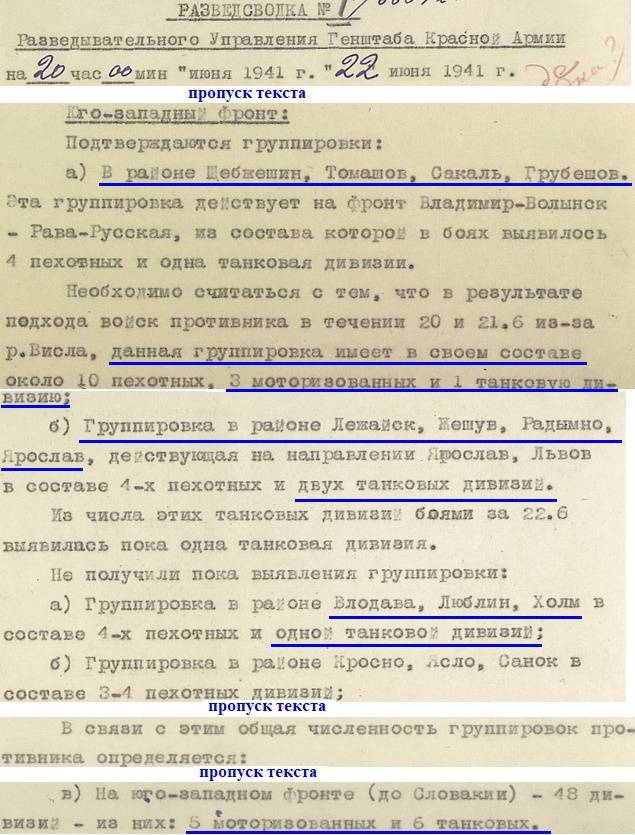
Below is a fragment of the map with the plotted data from the pre-war RM and with the areas of deployment of mobile units according to the data of the report No. 1 of the RU.
Information about the presence of one tank and three motorized divisions in the Hrubieszow - Sokal - Tomaszow - Szczebrzeszyn area is close to reality. However, all three MDs were discovered at the end of May 1941 and were nonexistent compounds. These are two md in the city of Zamoć and one in the Hrubieszow area. Therefore, the intelligence could never detect the exit of parts of these mythical formations directly to the state border ...
Thus, our intelligence was unable to detect the redeployment from Germany and from the Western direction of the mobile formations of the 1st TGr, to determine the places of concentration of these formations and the place of strikes by mobile groups.
The German command managed to create a deceptive picture of the concentration of a fictitious powerful strike group at the top of the Lvov ledge. Up to 2,5 mobile Hungarian compounds were also found there. An even more powerful fictitious strike group of up to 10 md, etc., was listed on the territory of Romania.
On the Voennoye Obozreniye website and in many studies, the movement of the micro spacecraft at the beginning of the war on the Lvov ledge is considered in accordance with the cover plans. However, these cover plans were developed at the General Staff and at the KOVO headquarters in late May - early June 1941. These plans were required to take into account the presence of non-existent strike groups at the top of the Lvov salient and in Romania.
Mobile troops against ZAPOVO
In the previous part, the RM was presented on the concentration of troops of the 3rd TGr on the Suvalka ledge. Therefore, in this section, we will consider only the issue of concentration of compounds of the 2nd TGr. The table below compares the RM from the report of the RU from 31.5.41 and the information available at the headquarters of the Western Military District about the enemy's mobile troops on the eve of the war.
The table shows that as of June 21:
1) 51% of motorized and tank regiments did not change their places of deployment, in which they were discovered at the end of May. It is assumed that TP consists of three TB;
2) out of 49% of the missing regiments, three regiments (21%) never existed in the Wehrmacht. It is possible that the servicemen who portrayed these dummies simply returned to their units;
3) none of the large headquarters of the mobile troops (the headquarters of the 58th MD, TD and TBR) changed their location from the end of May to 21 June;
4) in Demblin (117 km to the border), the Tbr appeared.
The redeployment of real motorized and tank units was again undetected by our reconnaissance forces.
On the evening of June 16, the 3rd, 4th, 17th, 18th TD, 10th, 29th MD and the SS Reich division were concentrated against the troops of the Western Military District.
At the railway station in the city of Lublin, the 10th TD was unloaded, which began to move to its divisional concentration area located south-west of the station. West of Lublin, the tracked part of the 10th MD, which arrived by rail, was concentrated. The wheel part of the 10th md moves towards it along the roads.
By the evening of June 19, the mobile units of the divisions remained in the same places of deployment as on the evening of June 16. From the map fragments it can be seen that units of the 3rd, 4th, 17th and 18th TD were concentrated at the border, but there were no tanks at the border at that time. This is evidenced, for example, by records in war log of the 3rd TD:
14.06.41 ... A careful camouflage is prescribed to the east of the prohibition line.
15.6.41 ... Since the division on June 16 at 0-00 takes over control of the border section, the 3rd and 394th Regiment will receive a special order to replace [the border guards].
16.6.41... The order on the protection of the border gives directives on the attitude towards the population of the border regions, whose freedom of movement is sharply limited in the near future ...
19.06.41 ... By order of the division commander, changes are taking place in the advancement plan, since on the night from B-3 to B-2 [from 19.6 to 20.6 - Approx. Auth.], In addition to the previously assigned units, the 3rd motorcycle battalion, the 1st reconnaissance battalion, the 543rd and 521st anti-tank battalions also entered their initial positions; on the night from B-2 to B-1 [from 20.6 to 21.6 - Approx. Auth.] The 3st and 6nd battalions of the same regiment were behind the 1rd battalion of the 2th TP. Thus, on the night from B-1 to B [from 21.6 to 22.6 - Approx. Auth.], Only the headquarters of the 5th tank brigade and the headquarters of the 6th tank regiment with the remaining divisions of the regiment leave the Radzyn area in the area of the initial positions ...
The reconnaissance battalion had 25 armored vehicles and no tanks. The motorcycle battalion had only cars and motorcycles. The first tanks of the 3rd TD began to move directly to the state border only on the night of June 20-21. Nothing could alert the intelligence and command of the border military units until June 21 ...
The figure below shows a report map of the headquarters of the Western Military District with the situation at 21.6.41. The map additionally contains the full names of some parts and compounds.
It can be seen from the figure that the headquarters of the Western Military District are confident that the German mobile troops are dispersed along the entire border. In the area of deployment of the 2nd TGR, of the mobile troops, there is only a brigade, two tp, mn and two cavalry brigades. Of the many thousands of vehicles of tank formations and formations of the 2nd TGr, only 300 vehicles are known ... It can be seen that most of the divisions and regiments of the grouping in the Brest region are located quite far from the border line.
Information from the KOVO map (SWF), a fragment of which is presented below, also testifies to the insignificant grouping of mobile troops in the Brest region.
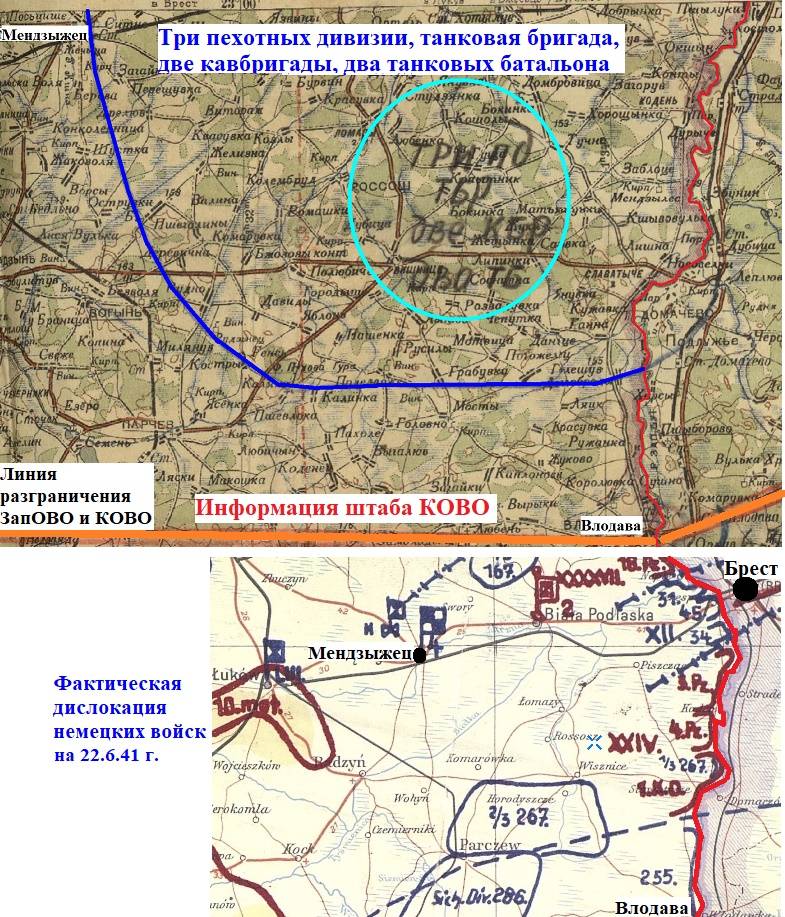
The information available at the KOVO headquarters about the enemy troops north of Wlodawa coincides with the data of the ZAPOVO headquarters and does not correspond to reality ...
Below on the map with the deployment of German formations by June 22, the author plotted the data of the last peaceful reports of the RO of the headquarters of ZAPOVO.
It can be seen from the figure that on the evening of June 21, ZapOVO scouts are sure that more than half of the German mobile troops are scattered along the entire border, and two such units are even located in the Minsk Mazovetsky - Warsaw area. A fairly solid grouping was "found" near Brest: up to two TD, up to two MD and up to three cavalry divisions. This grouping includes troops in the area of the town of Sedlec (two infantry divisions and two cavalry regiments) and a brigade in the area of the town of Demblin.
Thus, neither the headquarters of the ZapOVO, nor the RU, nor the General Staff know about the presence of the 2nd TGr in the Brest region. This is evidenced by the fact that neither in the operational reports of the General Staff for the 22nd day and in the morning of June 23, nor in the report of the RU for June 22, there is not a word about this direction ... This direction in the General Staff does not cause concern. there are no large strike groups in this area ...
Operator's bulletin No. 1 GSh at 10-00 on 22.6.41:
In the direction of Sokolow, Volkovysk, intense battles are going on in the Cheremkha region. By his actions in these two directions, the enemy obviously strives to cover the north-western grouping of the front ...
Operator's bulletin No. 2 GSh at 22-00 on 22.6.41:
A 10... Having repulsed the enemy offensive on Bialystok, he is fighting on the front Lomza, Tsekhanovets. The enemy retreats from Lomжа to Ostroleka.
In the area of Radun, Nacha in the period 16-42 - 17-54 parachute troops were dropped in the amount of 1000-1500 people.
13 microns - at 18-00 launched a counterattack in the direction of Botska, against enemy tanks that had broken through to Belsk.
6 microns are concentrated in the Bialystok area. The position of the rest of the army is being specified.
A 4... During the day, the army's troops fought stubborn battles with superior enemy forces on the Melnik, Brest-Litovsk line ...
Operator's bulletin No. 3 GSh at 8-00 on 23.6.41: «The Western Front... Front troops continue to engage in stubborn battles with the enemy force up to 30-32 infantry division, four TD and two MD, advancing on the Grodno and Belsk directions ... "
Operator's bulletin No. 4 GSh at 18-00 on 23.6.41: «The Western Front... 4 Army. At 5-30 TD the enemy launched an offensive on Zhabinka and 3 Infantry Divisions with tanks - from Brest to Kobrin ... "
Intelligence report of RU No. 1 at 20-00 on 22.6.41:
a) in the area of Mlawa, Ciehanów, Ostrolenka, Myshinets on the operational direction Bialystok, consisting of about 5 road units;
b) a grouping of troops in the region of Brest, Sedlets, Domachevo on the operational direction Brest - Kobrin, consisting of at least three infantry and one tank division.
c) a grouping to the east and north-east of Warsaw in the Malkin, Vyszków, Wengrów area, consisting of 6 infantry and one motorized division ...
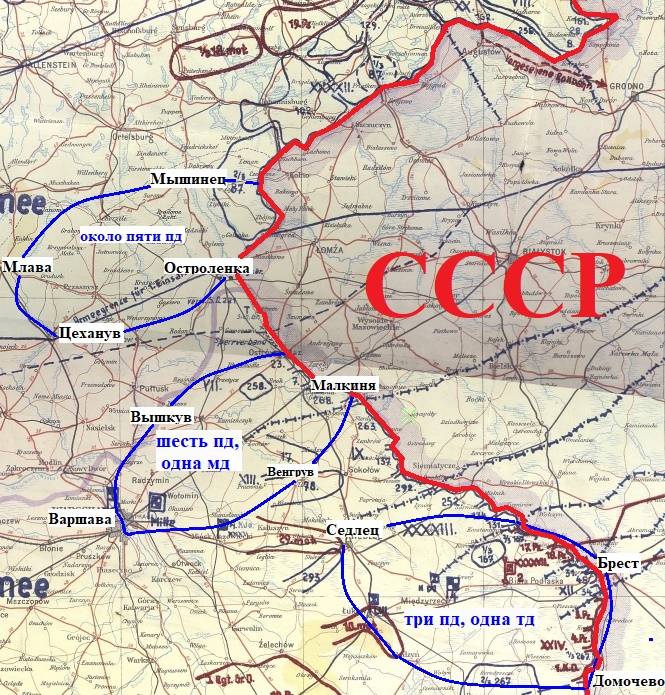
The number of "confirmed" divisions in the report of the Republic of Uzbekistan still does not correspond to reality ... The number of mobile formations concentrated against the Western Front in the Republic of Uzbekistan on the evening of June 22 is estimated at one MD, four TD and one cavalry division. The same number of divisions was "discovered" by reconnaissance by May 31, 1941. It can be seen that the impact of the MK 2nd TGr was unexpected both for the command of the ZAPOVO and spacecraft, and for reconnaissance.
Conclusions
In accordance with the materials and documents given in the article on mobile troops, the following conclusions can be drawn:
1. RM on the deployment of German troops at the Soviet-German border since the spring of 1940, significantly overestimated the number of enemy formations. Of the one TD, two tank brigades and five tank battalions discovered by reconnaissance at 8.8.40, in the territory of East Prussia and former Poland, in fact, there was not a single formation or unit that could be attributed to tank forces.
At the same time, the numbers of nonexistent one TD and four TP were known to intelligence and rechecked with the help of other sources of information. Such a situation could be only in one case: when these data were based on deliberate misinformation of the German command.
2. Until the end of May 1941, the RM on the deployment at the border of the German mobile troops significantly differed from their actual presence. For example, in the RM, given in the report of the RU dated May 31 (similar data are also presented in the report No. 5 RU of June 15), it was said about the presence in the territories:
- East Prussia and the former Poland - twelve tank and fifteen motorized divisions;
- Romania - four tank and six motorized divisions.
In fact, there was not a single German armored or motorized division in Romania at that time. On the territory of East Prussia and the former Poland at that time, in fact, there were only three TD and in total no more than one division in the Katowice area, which could have been parts of the 13th TD and MP "Great Germany".
When checking the RM with the data presented on the maps of the operational department of the General Staff of the Wehrmacht ground forces, it can be determined that not a single location of TD, MD, TP and MP, according to reconnaissance data, coincided with the actual areas of deployment of tank formations. Those. reconnaissance observed, rechecked and tracked non-existent units and divisions ...
3. By 22.6.41 from 50 to 80% of non-existent tank and motorized formations and units on the territory of East Prussia and former Poland were in the same places where they were "discovered" by reconnaissance at the end of May 1941.
By June 22, Romania still did not have a single German tank or motorized division out of ten, which our intelligence "discovered" and tracked until June 25 and even later.
At the same time, the concentration of the mobile formations of the four TGRs, the directions of their attacks and the exit of these troops directly to the state border were not detected by our intelligence services. This is evidenced by the maps of the headquarters of the PribOVO, ZAPOVO, KOVO prepared after the start of the war, the operational reports of the General Staff of the first days of the war and the report of the RU from 22.6.41. Therefore, for the command of the border military units, for the leadership of the spacecraft and the general staff, the strikes of the enemy's TGR were unexpected.
4. In the instruction of the High Command of the Wehrmacht, the Abwehr said: «Make an impression, that the main direction in our movements has been shifted to the southern regions of the General Government, to the protectorate and Austria ... "
In the Barborossa plan, the 11th Army headquarters, which commanded German troops in Romania, was assigned the following task: “To ensure the success of the offensive of Army Group South, the army must, demonstrating the deployment of large forces, pin down the opposing enemy, and in the future, as the offensive develops in other directions, in cooperation with aviation prevent the organized withdrawal of the Russians beyond the river. Dnieper...".
By June 22, in the southern part of the General Government, in Slovakia, in the Carpathian Ukraine and on the territory of Romania, up to 94-98 German divisions, of which up to 26 were motorized and tank divisions, were able to “detect” the disinformation measures carried out within the framework of the above instructions.
According to intelligence, up to 35-37% of mobile units were located against the PribOVO and ZAPOVO (in the so-called secondary direction), which were dispersed along our border.
The real picture was more ominous. A grouping of mobile forces was concentrated against these military units, which accounted for over 70% of all tank and motorized divisions that the German command allocated for the war with the Soviet Union.
5. On June 21 and 22, the People's Commissariat of Defense and the General Staff practically do not understand what is happening in the adjacent border area. Lacking reliable RM, not understanding what was happening on the border and assuming that the German groupings were not completely concentrated near the border, the SC command in the afternoon of June 22 insisted on a meeting with Stalin on striking the border military units.
Directive of the People's Commissar of the USSR No. 3 22.6.41:
... d) The armies of the Southwestern Front, firmly holding the border with Hungary, concentric strikes in the general direction of Lublin with forces of 5 and 6A, at least five microns and all aviation of the front, surround and destroy the enemy grouping advancing on the front Vladimir-Volynsky, Krystynopol , by the end of 26.6 capture the Lublin region. Secure yourself from the Krakow direction ...
People's Commissar of Defense of the USSR Marshal of the Soviet Union S. Tymoshenko
Malenkov, member of the Main Military Council
Chief of the General Staff of the Red Army, General of the Army Zhukov
This decision was based on pre-war unreliable RMs, which did not even closely reflect the actual situation at the border. The chief of the General Staff quickly left for the headquarters of the South-Western Front to organize counterattacks against the invading "small" enemy forces and for a further offensive on Lublin. When making this decision, the People's Commissar of Defense and the Chief of the General Staff could only be guided by the RM about the German troops, which are presented below in the figure.
It was very tempting to defeat the few invading German divisions and deliver a swift attack with mechanized corps at the main enemy forces that had not finished concentrating ...
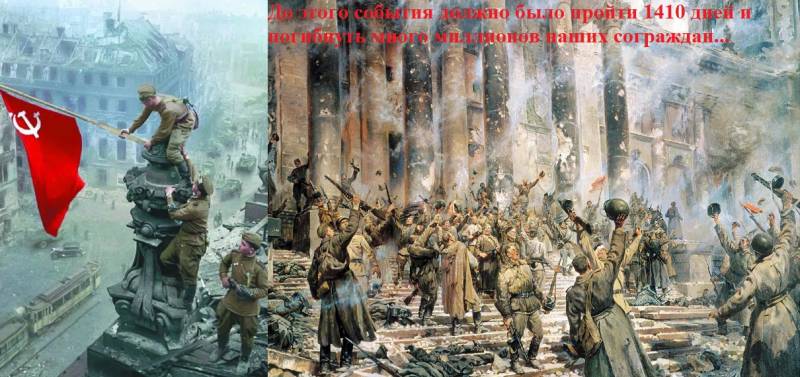

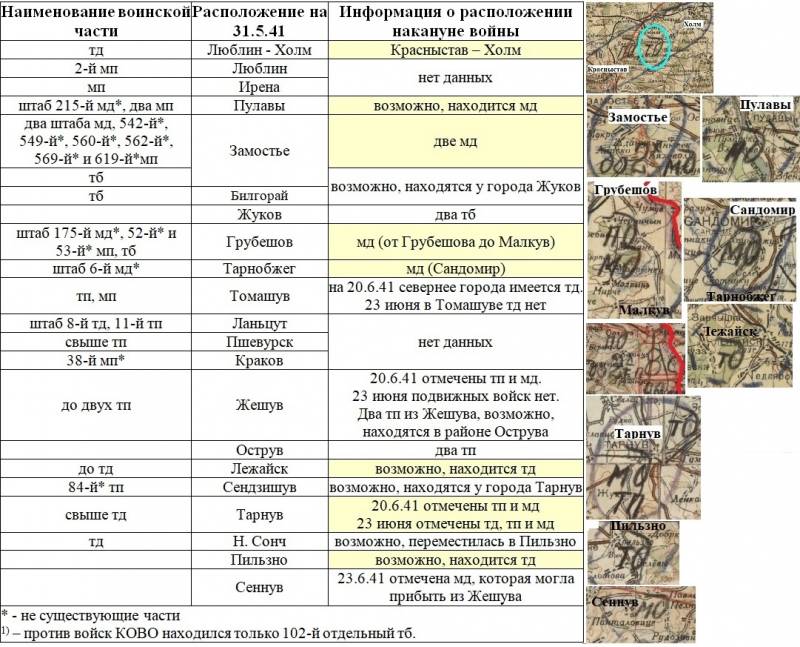
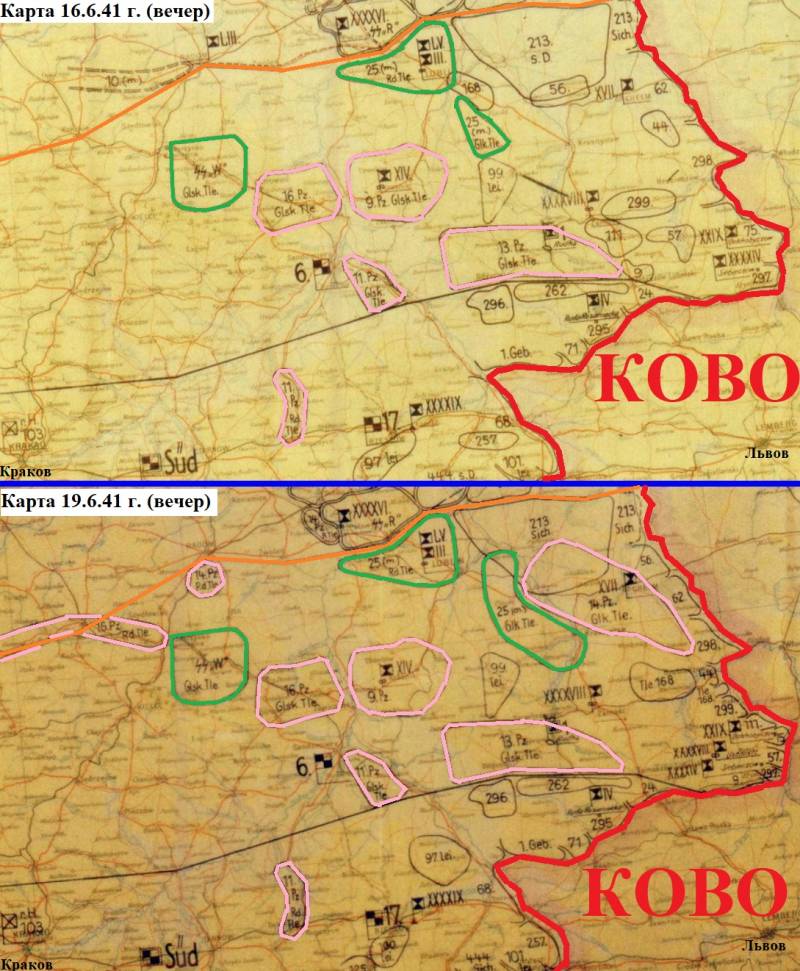
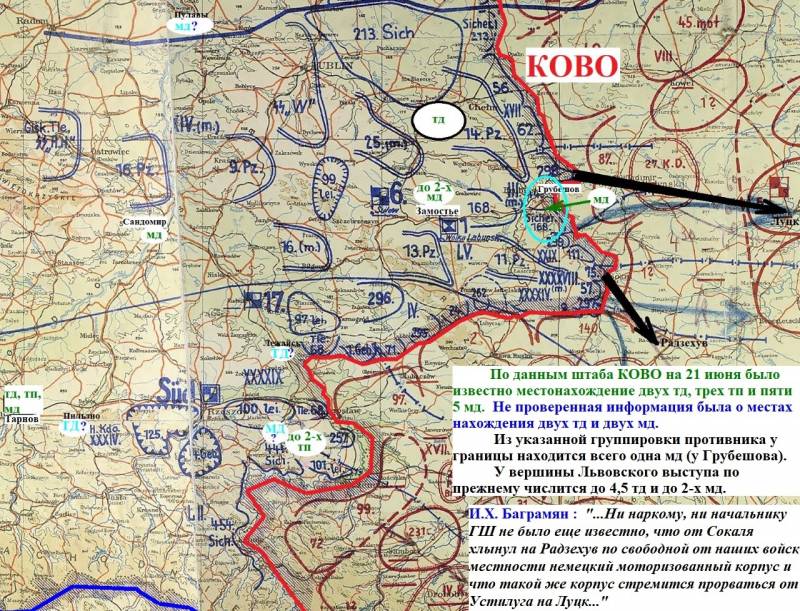
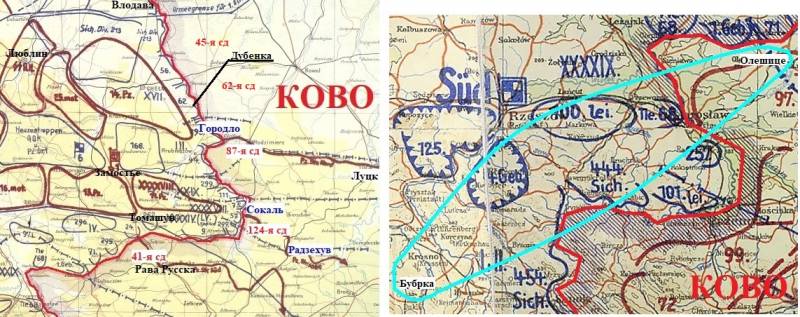
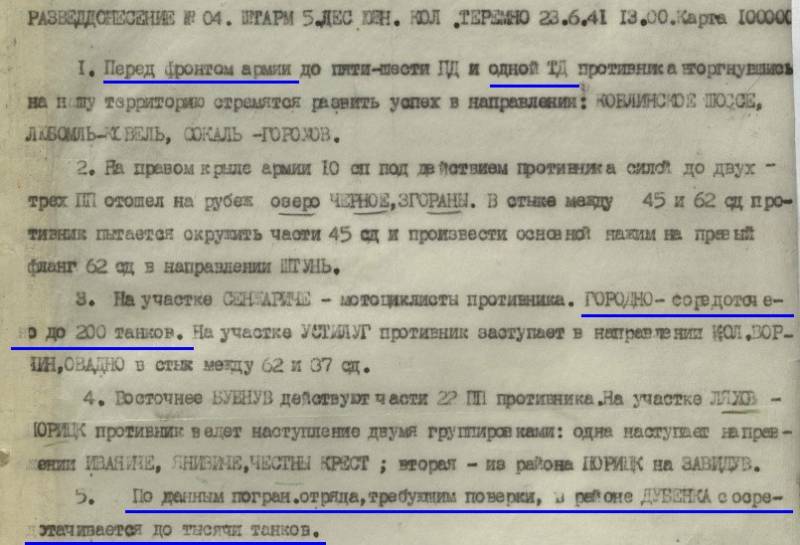
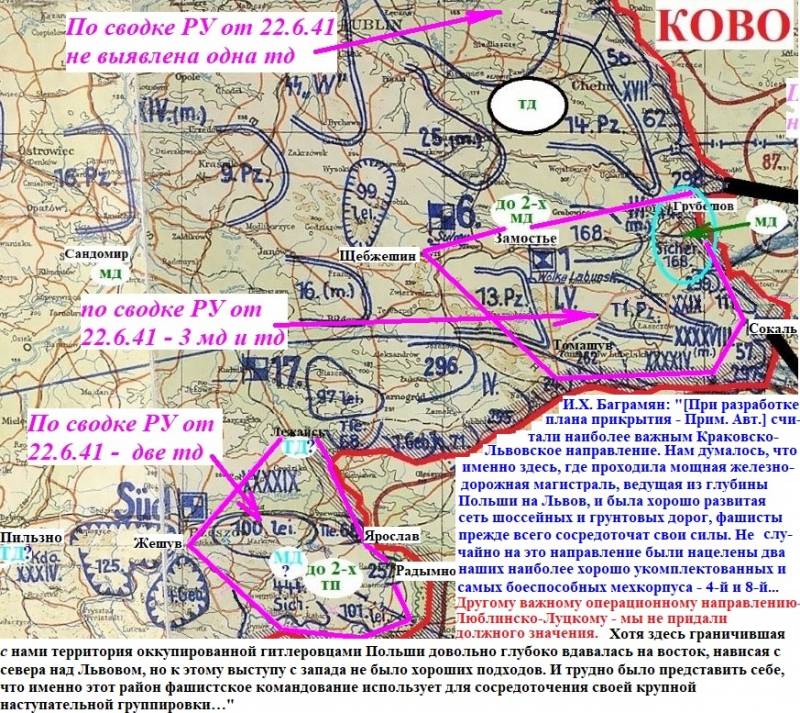
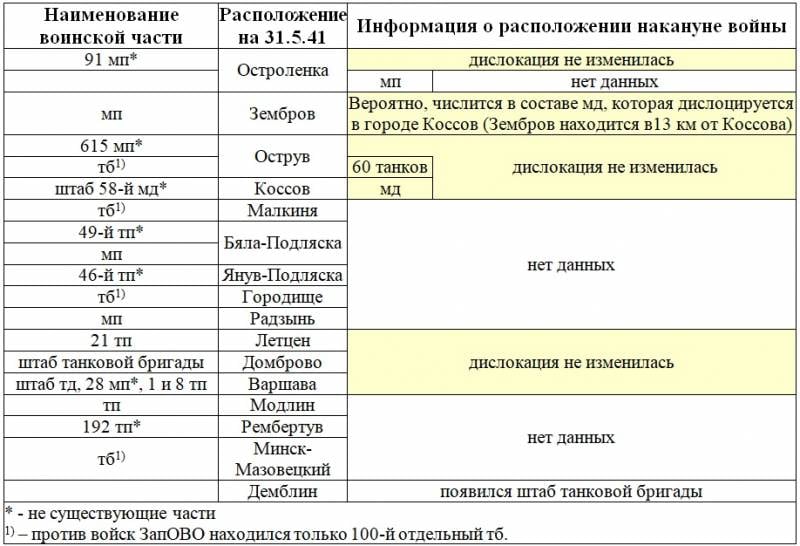
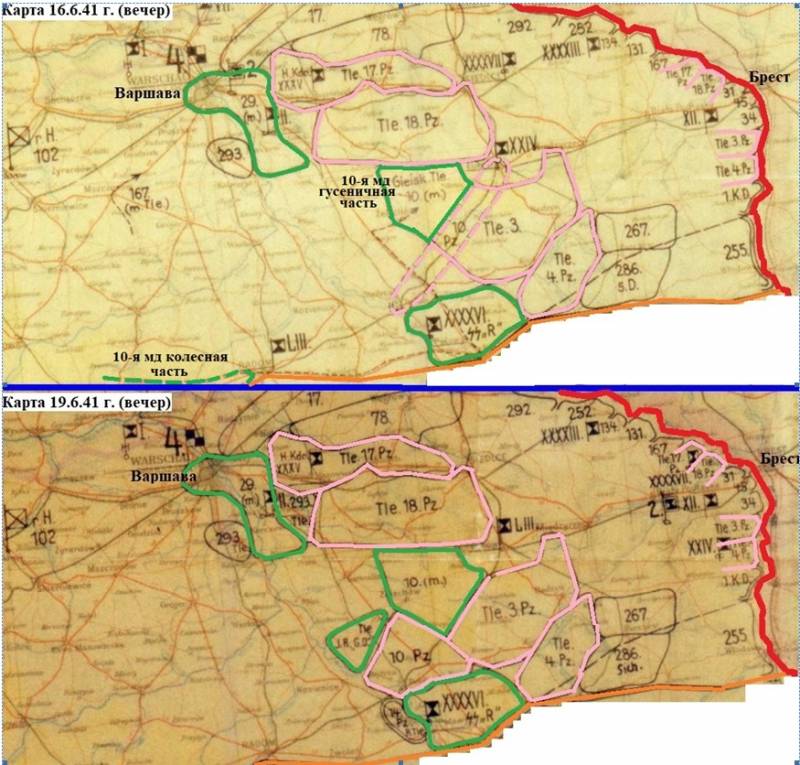
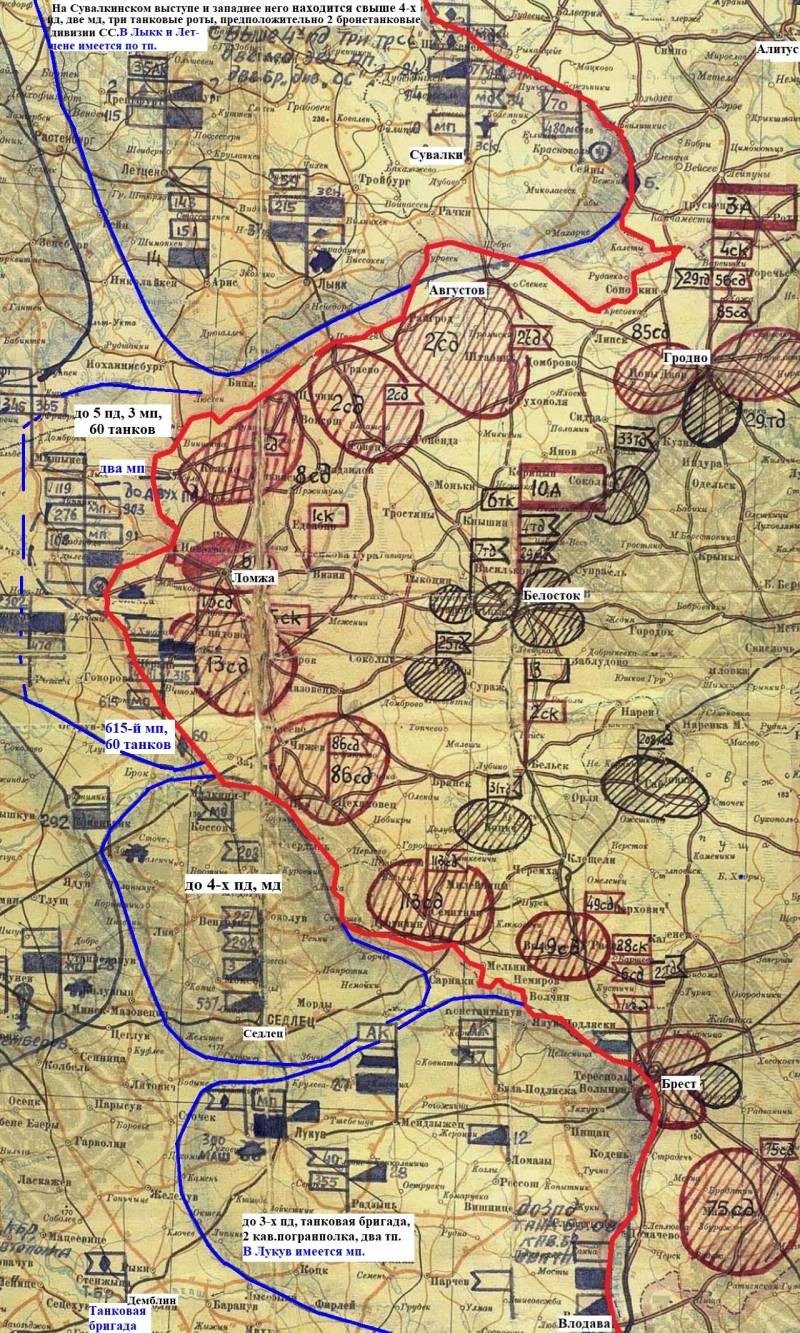
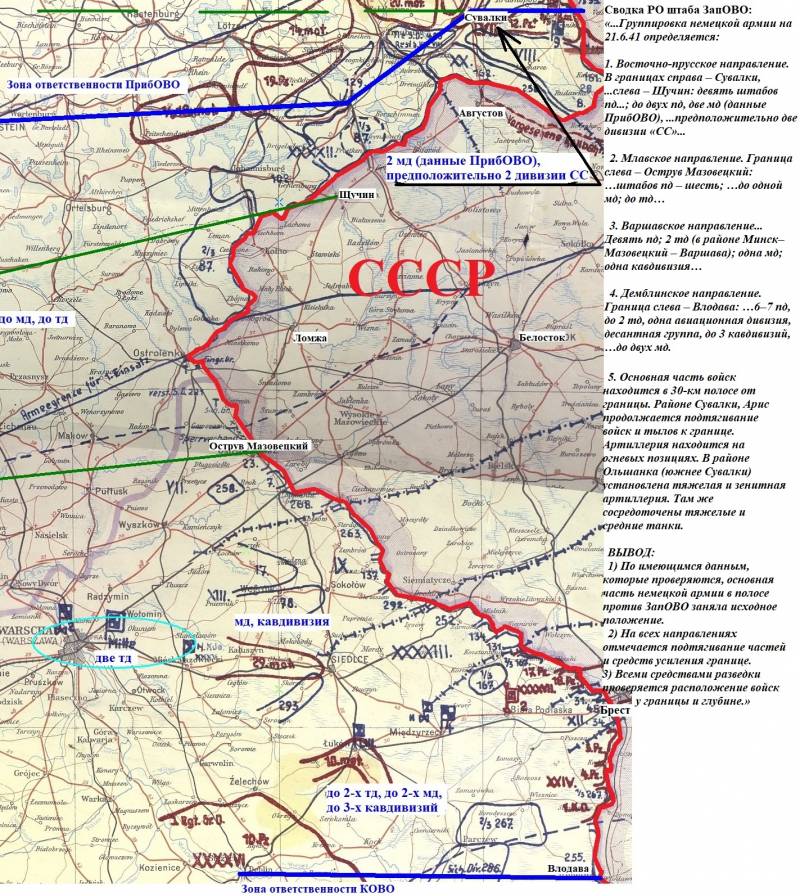
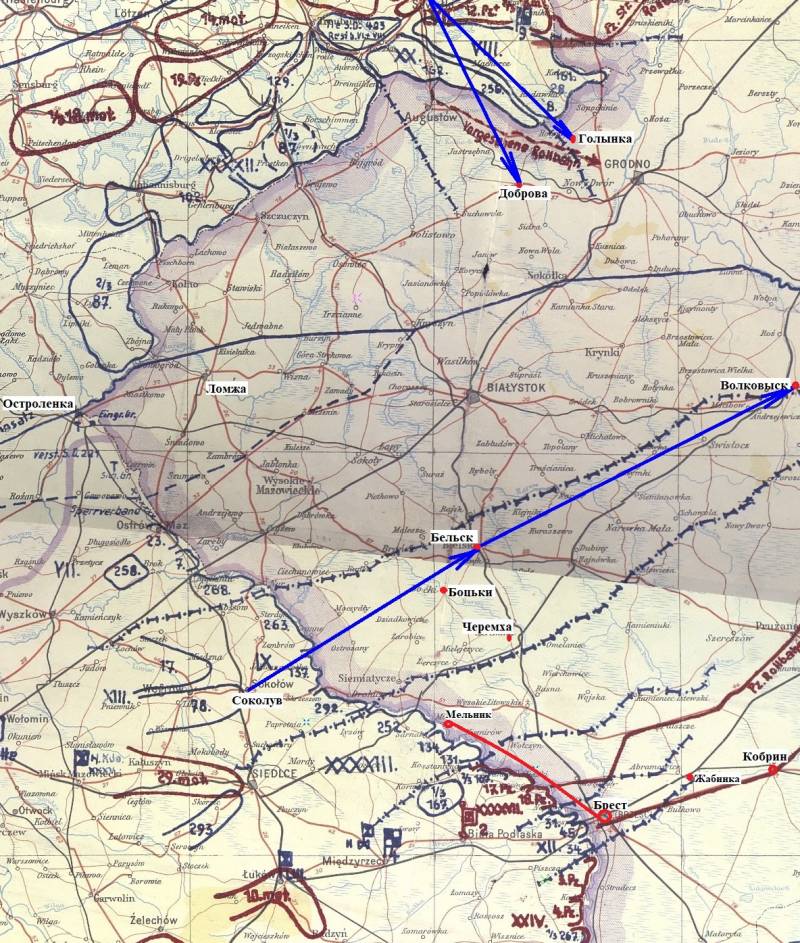
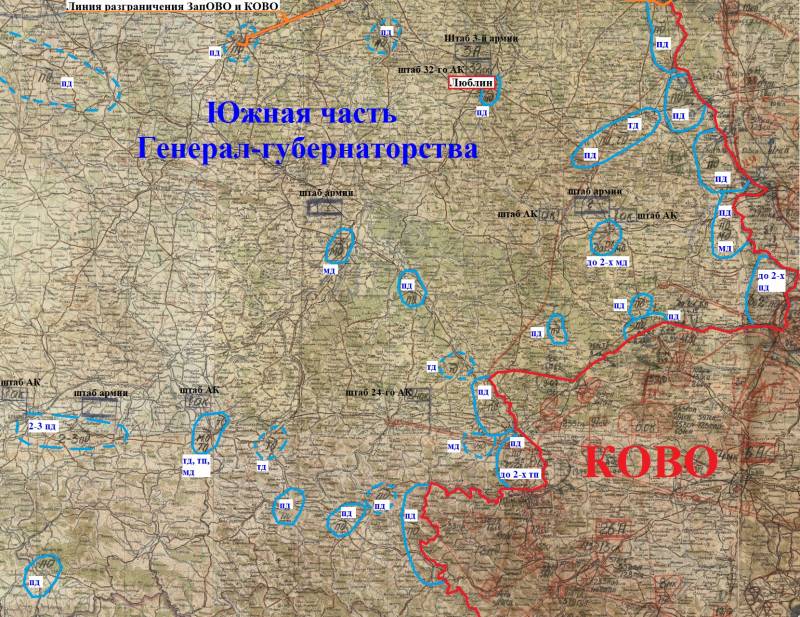
Information